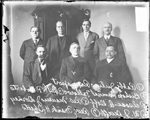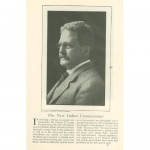
Ojibwe Girls in a Classroom at the St. Benedict’s Mission School, White Earth Reservation, circa 1900
The Bureau of Indian Affairs’ mission was always to “manage” Indian relations, but its mission changed over time until “civilizing” Indians through the reservation system became its primary one. Part of the Indian Office’s (which the agency was more generally known by) policy included dismantling traditional tribal governments and assimilating native peoples into the broader white culture.
As it did so, the Indian Office allowed disservice after disservice to Native Americans. In 1903, a Washington dispatch to the Chicago Daily News discussed an emerging scandal which the paper then covered. The Interior Department and the Justice Department had become interested in companies trying to acquire Indian land at “ridiculously low figures and selling them at their actual values.” Bad in itself, the article also reported that: “Members of the Dawes commission are said to be implicated in the alleged efforts ‘to fleece the Indians.'”
The irony, as the paper put it, was that “in several instances the very men who are now implicated in the effort to fleece the Indians came to Washington to consult with the heads of the departments (Interior and Justice) here in devising a plan for the Indians’ protection.”




